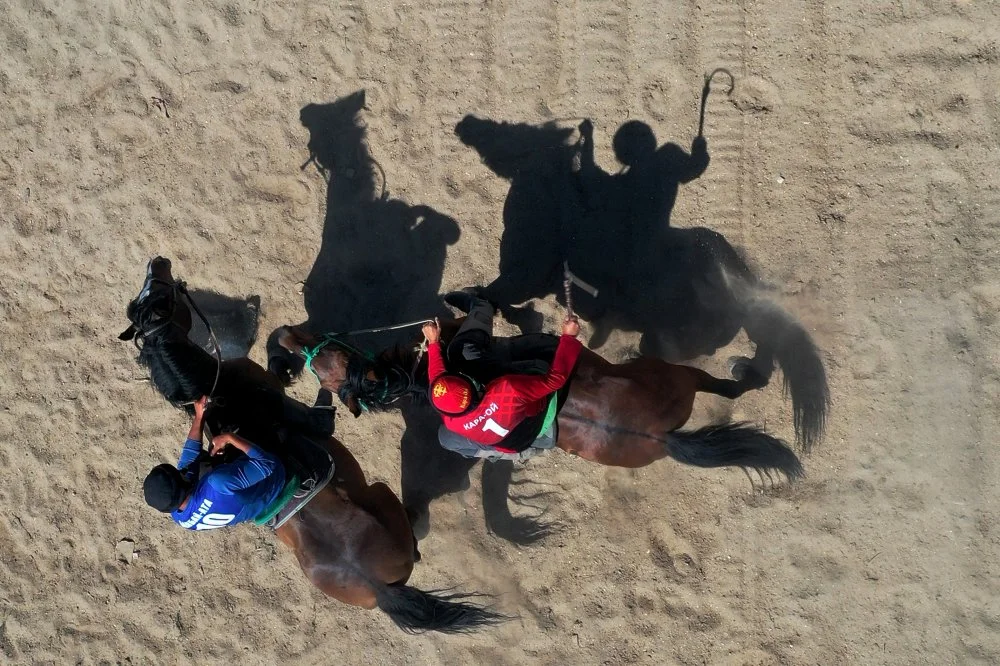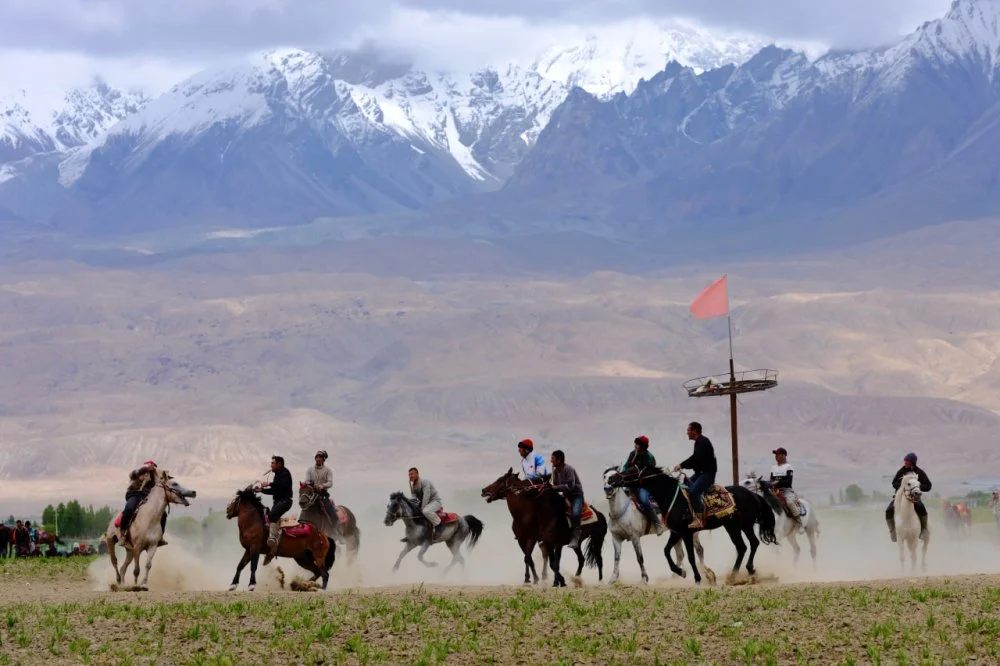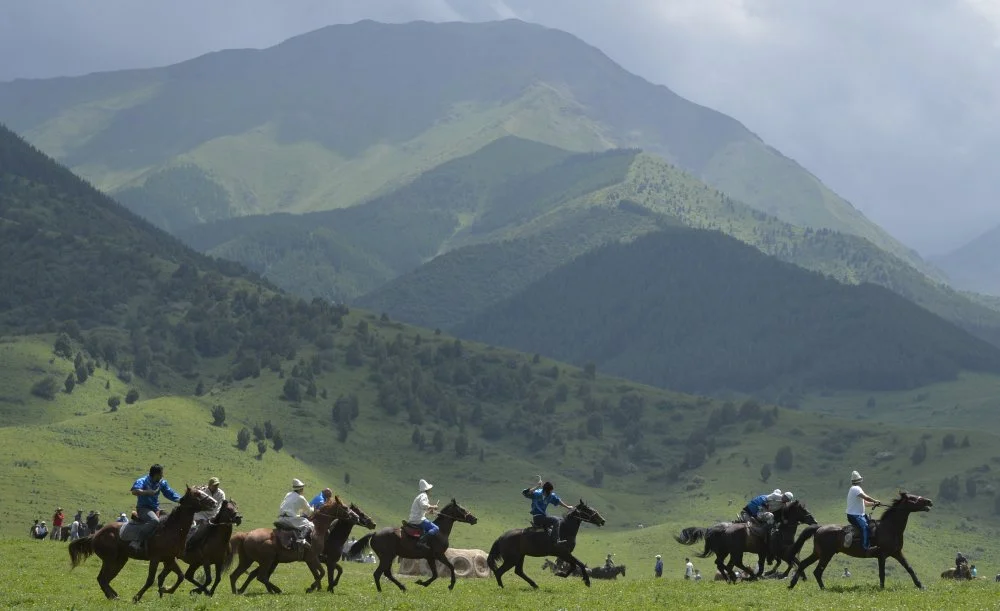The kök böri competition at the Nomad Games always attracts special attention from spectators, and it’s no wonder. In addition to the colorful spectacle, the game of kök böri awakens memories of the past in the soul—of true freedom paid for by true courage.
The rules of kök böri are simple: two teams of eight to twelve riders on each side compete to wrestle a decapitated goat carcass away from each other. In the modern version of the sport, the carcass must be carried to the ‘cauldron’—the opponent’s goal—and thrown into it. In older versions, the carcass had to be carried to a certain point in your own half of the field.
The Kazakh word for game is oyyn, which is often taken as an abbreviation of the words ‘oydy yntalandyru’, meaning ‘encouragement of thought’ or ‘training of the mind’. This is because kök böri, unlike any other ‘game’ in the sense that Europeans or Americans understand it, is not so much about winning, about competition, but about the process itself. The main result of the training lies in the coherence and efficiency of the player’s movements, in the control of the horse and one’s own body, and not just in a simple score. During the game, the teams snatch a goat carcass from each other, which must be carried through the line of opponents and thrown into the gate, or ‘cauldron’. The cheers of the spectators sound not only because of the act of scoring but also because of the skill of the players during the game. Interestingly, before the 1990s, Kazakh kök böri did not have a cauldron, and this element came from the Kyrgyz version of the game. In this sense, Kazakh kök böri was more like rugby or American football, where it was enough to carry the ball over the line on the field to win a point.

This aerial picture shows horse riders playing the traditional Central Asian sport of "Kok-Boru" (Gray Wolf) or "Buzkashi" (Goat Grabbing), a medieval Kyrgyz warrior, in Cholpon-Ata on June 1, 2024/VYACHESLAV OSELEDKO/AFP via Getty Images
Remember that steppe battles were very different from European battles, where two armies met head-on, flank to flank, on the battlefield. In both the steppe and ancient times, the front line could stretch for dozens of kilometers, clashes could last for weeks, and almost all battles were mounted. Fighting in small groups was exhausting, and it ceased only when reinforcements arrived or the participants died—and it required exceptional military skill. That is why it was so important for a steppe fighter to be able to control a horse like his own body, to feel everything—the enemy, the terrain, every movement. In that sense, kök böri was the ideal way to train a fighter for this kind of battle.

Russian (white) and Kazakh (blue) riders play the traditional Central Asian sport Buzkashi also known as Kok-Boru or Oglak Tartis during the World Nomad Games 2018 in Cholpon-Ata, eastern Kirghizstan, on September 5, 2018/Getty Images
In the past, kök böri contests were usually held during major celebrations, such as the birth of a prominent person’s long-awaited heir, Nowruz, or other seasonal holidays. But even with such restrictions, every young man could test his strength several times a year, improve his morale, and discover his strengths and weaknesses. Of course, warriors were also evaluated by their commanders during these contests. As a result, the raids of neighboring tribes were not met by peaceful shepherds but by horsemen accustomed to confrontation and fighting for victory. If we remember that using the kamcha whip during kök böri was forbidden only recently, we should also realize that kök böri was once a very severe test not only of the spirit but also of the body.
The original design of the game is said to be based on observing two packs of wolves fighting over the carcass of a goat. The wolf, the sacred animal of the Turkic people, is known for having the most coordinated group behavior of all animals, not just predators. The agility and variety of tactics of the pack during a hunt could well be the envy of many human fighting groups. The Kyrgyz even call kök böri ‘kôk-bôru̇’, meaning ‘heavenly wolf’.

Nomad Horse Rider Playing Traditional Nomadic Horse Game Of Buzkashi Known Also As Kokpar, In Issyk Kul, Kyrgyzstan/Alamy
Historically, many nations— the Hungarians, all Mongolian and Turkic peoples, and even the inhabitants of North America after horses were domesticated there—have played something similar to kök böri. Even today, kök böri can be called an international game; teams from dozens of countries take part in the competitions. Numerous disputes and splits in the organizations related to the games, however, have slowed down the development of kök böri as a professional sport. This is a natural process that once took place in most sports, from football to chess; it is not an easy task to unify different traditional rules from a number of nations. For example, the rule about gates, or cauldrons, proposed by the Kyrgyz has caused a lot of discontent among other players, who believe that such rules impoverish and simplify the game. In addition, gates are unsafe for both horses and players as they are an obstacle over which horses often stumble, injuring themselves and endangering the life of the rider.

KASHGAR, CHINA - JUNE 20: Horsemen of the Tajik ethnic group vie for a goat during a goat grabbing competition on June 20, 2024 in Tashkurgan Tajik Autonomous County, Kashgar Prefecture, Xinjiang Uygur Autonomous Region of China/ Ding Xiaochun/VCG via Getty Images
Perhaps in a dozen years we will see a truly professional change in kök böri with the implementation of proper regulations, standards, and international rules. In the meantime, the game retains a more traditional character. For example, many of the successful competitors who devote a lot of time and effort to the game are amateurs in the truest sense of the word. They are dentists, taxi drivers, office managers, et cetera. Children and teenagers learn kök böri not in special schools with elite coaches but in their home villages, where tournaments are often held privately during vacations. Of course, there are clubs and schools in Kazakhstan that teach kök böri, but they are few and far between. Unfortunately, like many national games, kök böri has long been under the strong influence of religious organizations, which have tried to give the folk game a primarily religious status, something that is alien to its original spirit.
The equality of men and women in the steppe always allowed women to participate in competitions. Girls could sit in the saddle and take up weapons if necessary, and thus military training for girls was quite encouraged by our ancestors—of course, if the girl had such a desire. At the same time, there are no separate women’s teams in kök böri at the moment—they fight together with men.

Mounted Kyrgyz riders play the traditional central Asian sport Kok-boru, know also as Buzkashi or Ulak Tartis ("goat grabbing"), during a folk festival at Kyrgyzstan's Chon-Kurchak valley, some 30km outside Bishkek, on June 17, 2017/VYACHESLAV OSELEDKO/AFP via Getty Images
